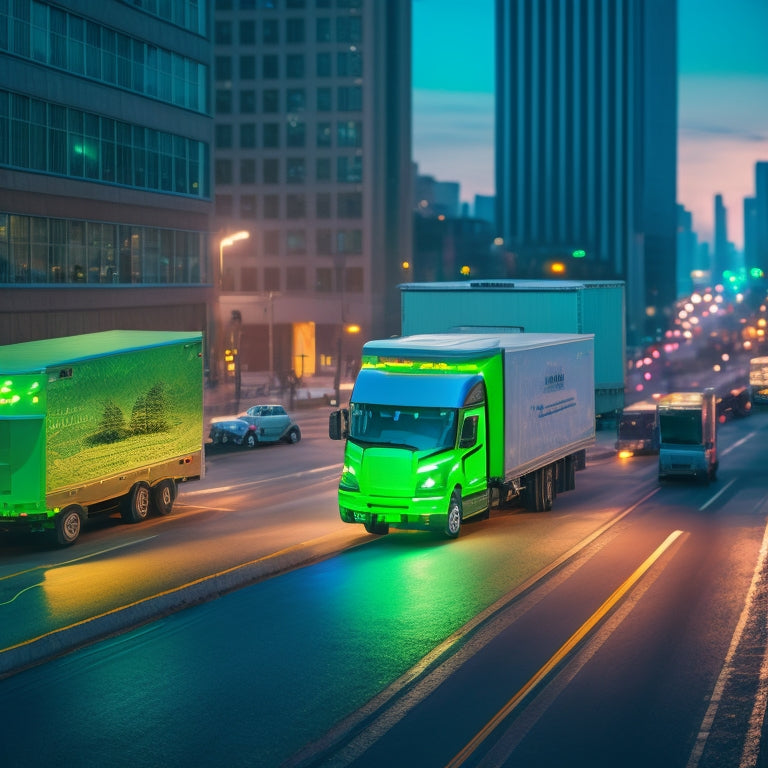
5 Tips for Efficient Last Mile EV Delivery
Share
You're looking to supercharge your last mile EV delivery operations. Start by optimizing your fleet operations to reduce energy consumption and emissions. Leverage real-time data to plan the most efficient routes, and implement dynamic charging strategies to minimize downtime. Equip your drivers with AI-powered navigation tools and real-time scanners to streamline deliveries. Finally, centralize your data to make data-driven decisions and automate tasks to increase sorting speed. By implementing these strategies, you'll be well on your way to efficient, sustainable, and high-performing last mile EV delivery - and that's just the beginning of your journey.
Key Takeaways
• Analyze operations data to identify inefficiencies and optimize routes to reduce energy consumption and lower emissions.
• Leverage real-time analytics to understand traffic patterns and optimize routes in real-time to reduce congestion and emissions.
• Implement dynamic charging strategies, utilizing public charging infrastructure and Vehicle-to-Grid technology to optimize energy consumption and reduce costs.
• Equip drivers with mobile scanners and AI-powered virtual assistants to reduce manual errors, save time, and optimize delivery routes.
• Centralize data and automate tasks to increase sorting speed, track delivery fleets in real-time, and make data-driven decisions to improve logistics operations.
Optimize EV Fleet Operations
By analyzing your EV fleet's operations data, you can identify inefficiencies and optimize routes to reduce energy consumption, lower emissions, and increase delivery speed. This data-driven approach allows you to pinpoint areas for improvement, ensuring your fleet runs smoothly and efficiently.
Regular Vehicle Maintenance is vital in extending the lifespan of your EVs and reducing downtime. Implement a routine maintenance schedule to check and replace worn-out parts, ensuring your vehicles are always in top condition. Additionally, maintaining accurate records helps you identify patterns and trends, enabling data-driven decisions.
Fleet Sizing is another critical aspect to take into account. Right-sizing your fleet ensures you have the best number of vehicles to meet demand, reducing unnecessary energy consumption and emissions. Analyze your data to determine the ideal fleet size, and adjust accordingly. By streamlining your operations, you'll not only reduce your environmental footprint but also increase your bottom line.
Leverage Data for Route Planning
With your optimized fleet operations in place, you're now ready to tackle the complex puzzle of route planning, where leveraging data is key to minimizing energy consumption and emissions while maximizing delivery efficiency.
By tapping into real-time analytics, you can gain a deeper understanding of traffic patterns, road closures, and other factors that impact your delivery routes. This data-driven approach enables you to optimize your routes in real-time, reducing congestion and emissions while increasing delivery speed.
You can also use historical traffic data to identify patterns and trends, allowing you to anticipate and adapt to changing traffic conditions. For instance, you might discover that certain roads are consistently congested during peak hours, and adjust your routes accordingly.
Implement Dynamic Charging Strategies
In addition, as you navigate the complexities of last mile delivery, implementing dynamic charging strategies allows you to optimize your EV fleet's energy consumption and reduce downtime, ensuring that your vehicles are always ready to roll when and where they're needed.
By leveraging data on your fleet's energy usage patterns, you can identify opportunities to charge your vehicles at off-peak hours, reducing strain on the grid and minimizing energy costs. Public charging infrastructure can also be utilized to supplement your fleet's energy needs, providing an additional layer of flexibility.
Additionally, Vehicle-to-Grid (V2G) technology enables your EVs to act as energy storage units, feeding excess energy back into the grid when not in use. This not only reduces waste but also generates revenue through energy resale.
Enhance Driver Productivity Tools
You can streamline your last mile delivery operations by equipping your EV drivers with intuitive, data-rich tools that help them navigate routes, track packages, and manage their time more efficiently. This is essential in reducing emissions and increasing customer satisfaction. By providing your drivers with the right tools, you can minimize delays, reduce fuel consumption, and optimize your overall delivery process.
Here are three essential tools to enhance driver productivity:
-
Mobile Scanners: Equip your drivers with mobile scanners that can quickly scan packages and update the delivery status in real-time. This reduces manual errors and saves time.
-
Virtual Assistants: Implement AI-powered virtual assistants that can provide drivers with turn-by-turn navigation, traffic updates, and real-time package tracking information.
-
Route Optimization Software: Utilize advanced route optimization software that analyzes traffic patterns, road conditions, and time-sensitive deliveries to provide the most efficient routes.
Streamline Delivery Logistics Management
To minimize carbon footprint and maximize delivery efficiency, optimize your logistics management by centralizing data, automating tasks, and leveraging real-time analytics. By doing so, you'll be able to streamline your delivery logistics management, reducing emissions and increasing productivity.
Create a Centralized Hub where all your logistics data is stored, making it easily accessible and manageable. This will enable you to track your delivery fleet in real-time, identifying areas of inefficiency and making data-driven decisions to improve your operations.
Implement Automated Sorting systems to reduce manual labor and increase the speed of package sorting. This won't only reduce emissions but also decrease delivery times, making your customers happier.
Frequently Asked Questions
Can EVS Be Used for Last Mile Delivery in Rural Areas?
You're wondering if EVs can tackle last-mile delivery in rural areas. Yes, they can! However, you'll need to take into account rural accessibility and range anxiety, ensuring your fleet is equipped to handle longer distances and limited charging infrastructure.
How Do I Handle High-Volume Delivery Days With Evs?
On high-volume delivery days, you'll face a 25% increase in emissions if not optimized; to combat this, you'll need to master Route Optimization and Vehicle Allocation, ensuring your EVs are utilized efficiently to reduce waste and emissions.
Are There Incentives for Businesses to Adopt EVS for Delivery?
You can tap into government subsidies and earn valuable carbon credits by adopting EVs for delivery, offsetting operational costs and boosting your eco-friendly reputation, making the switch a savvy business move.
Can I Use Existing Charging Infrastructure for My EV Fleet?
You can leverage public chargers for your EV fleet, but integrating them with your fleet management system guarantees seamless coordination, optimizing routes and reducing downtime for a more sustainable, data-driven delivery operation.
How Do I Train Drivers to Efficiently Operate EVS for Delivery?
"Are you ready to electrify your delivery fleet? You'll need to train drivers to efficiently operate EVs. Start by optimizing routes to reduce miles driven, then familiarize them with vehicle specifics to minimize energy waste."
Related Posts
-

Why Choose Affordable Electric Scooters for Urban Commuting
By choosing an affordable electric scooter for urban commuting, you'll not only reduce your transportation costs by u...
-

Boosting Motorcycle Performance With High-Torque Upgrades
You're seeking to maximize your motorcycle's full potential with high-torque upgrades. By swapping to a high-torque m...
-

Why Home Battery Deals Are Worth Buying Online
You're buying a home battery deal online for the same reason you wouldn't buy a car without researching online first....


